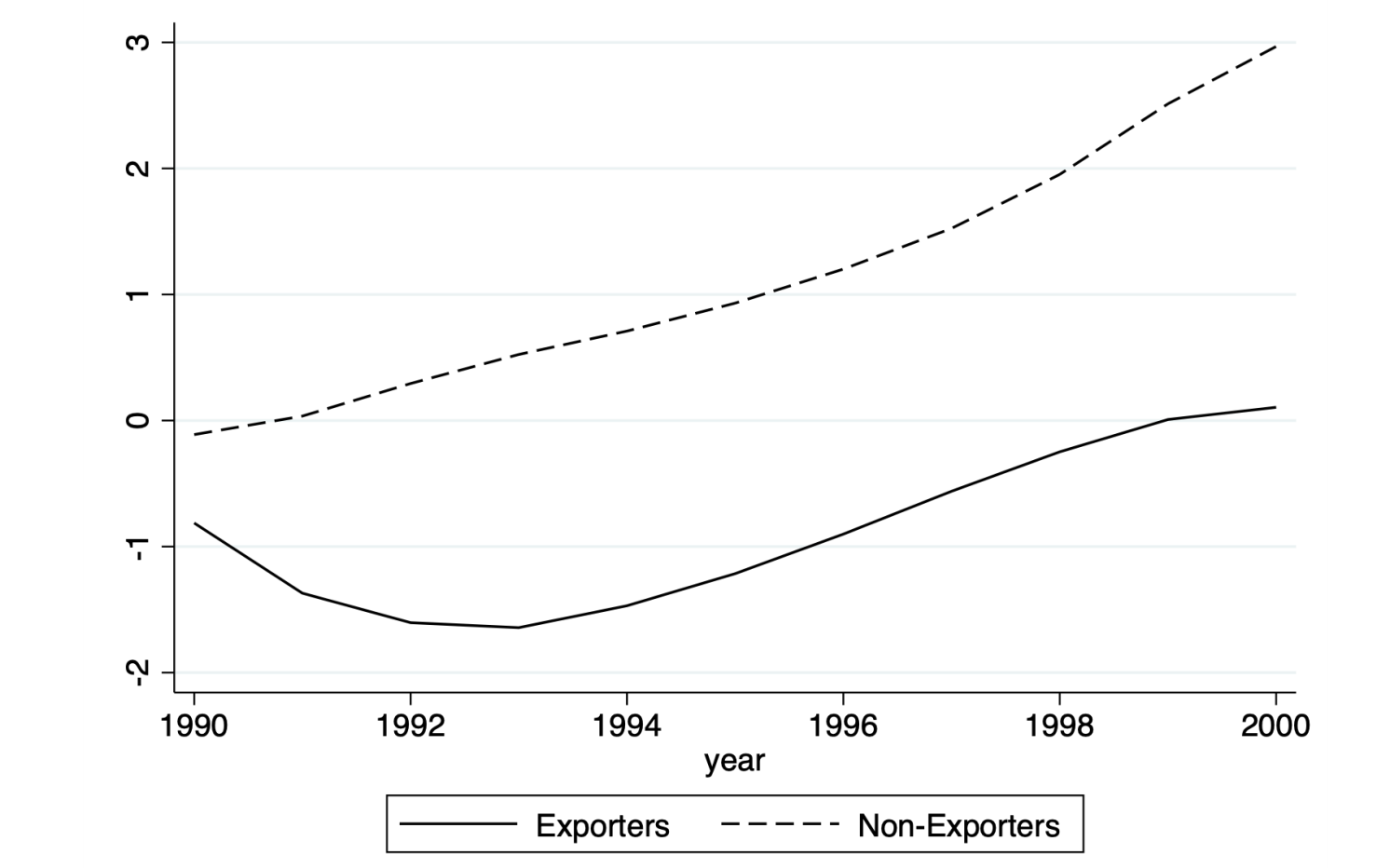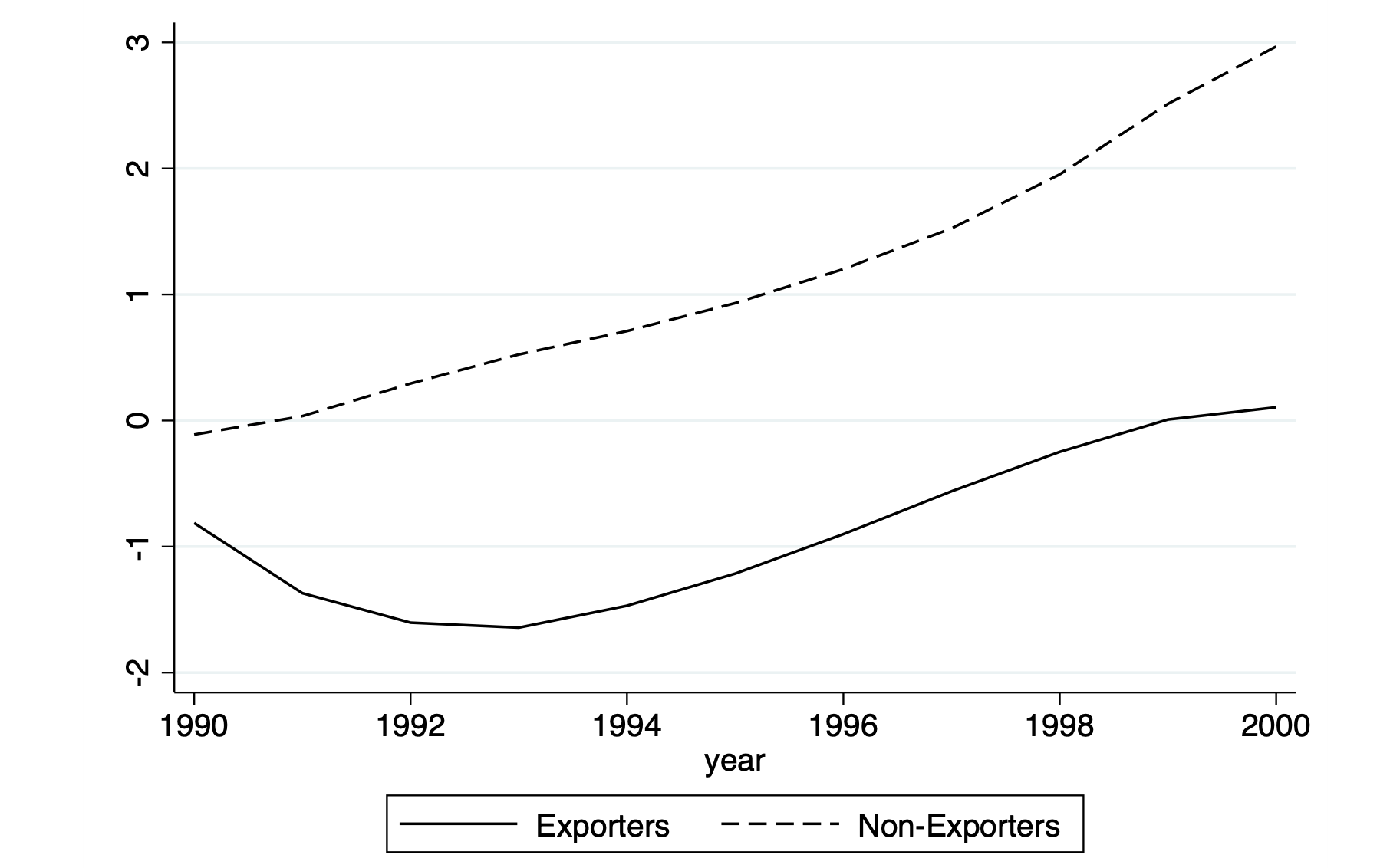June 10, 2024 – EUGENIA ANDREASEN, SOFIA BAUDUCCO AND EVANGELINA DARDATI
Previously published on VoxEU on June 7, 2024.
Capital controls re-emerged as a tool for policymakers grappling with volatile capital flows after the 2008 financial crisis. This column explores the heterogeneous effects that capital controls have on firms, focusing particularly on capital intensity and export status during the Chilean ‘encaje’, which was implemented between 1991 and 1998 to restrict capital inflows to the country. The authors suggest that capital controls impact firms differently – with exporters in capital-intensive sectors experiencing the most negative effects – and attribute these variations to increased financing costs, real exchange-rate depreciation, and shifts in industry composition.
The impact of capital controls on firms is a topic of growing interest among economists and policymakers. Initially deemed detrimental after the collapse of the Bretton Woods system, they gained favour after the sudden stops and 2008 financial crisis as a macroprudential tool (Wandschneider and Mitchner 2014, Monnet 2018, Loungani et al. 2022). Despite their growing popularity, the specific effects of CCs on individual firms have received limited attention, with only a handful of papers exploring the issue empirically. In our recent paper (Andreasen et al. 2024), we delve into this aspect, with a specific emphasis on the Chilean ‘encaje’ implemented between 1991 and 1998. By leveraging empirical data alongside a general equilibrium model, our study aims to explore in detail how capital controls reshape firms’ behaviour and economic dynamics.
Impact on firm performance
Empirical studies suggest that capital controls have a dampening effect on firm financing and investment (Forbes 2007, Alfaro et al. 2017, Chari et al. 2015). We begin by exploring the differential effects of CCs on firms that may have stronger financing needs, such as exporters and firms operating in more capital-intensive sectors, with respect to non-exporters and firms in less capital-intensive sectors. Using data from Chilean manufacturing firms (1990–2007), 1 Figure 1 illustrates the varying effects of capital controls on exports, domestic sales, and capital accumulation across different capital intensity levels and export status.
Figure 1 Percentage change in firms’ outcomes by level of capital intensity


Note: Vertical axis measures the percentage change in the corresponding dependent variable triggered by the credit control for each level of capital intensity, which is measured on the horizontal axis. Solid and dotted lines show the estimated effect of the credit control for each level of capital intensity for the subsample of exporters and non-exporters, respectively. The shaded areas are the corresponding 95% confidence intervals.
Our findings underscore distinct responses between exporters and non-exporters within high capital-intensive sectors. For exporters, firms in capital-intensive sectors face more negative (or less positive) effects in terms of exports, domestic sales, and capital compared to firms in less capital-intensive sectors. Considering the empirical literature previously mentioned, these results are intuitive. In the case of non-exporters, though firms in capital-intensive sectors experience more negative effects in terms of capital, the opposite is true when considering domestic sales. The latter finding is at odds with the previous intuition that capital controls would negatively impact firm size and, thus, sales for firms more reliant on debt.
Figure 2 Change in share of high-capital intensity firms


Note: Figure plots the smoothed percentage change of the share of high-capital intensity firms within exporters and non-exporters with respect to the respective shares in 1990.
These heterogeneous responses between exporters and non-exporters encompass effects on the intensive and extensive margins of exports. Figure 2 complements the analysis by depicting the compositional changes within exporters and non-exporters. Specifically, the figure illustrates the variation in the share of high capital-intensive firms among exporters and non-exporters over time, relative to 1990. The implementation of capital controls led to a notable decrease in the share of high capital-intensive firms in the exporting sector, while witnessing an increase among non-exporting firms. This pattern suggests that the heightened vulnerability felt by more capital-intensive firms and exporters due to their elevated financing requirements may also play a role in explaining the response of non-exporters to capital controls .
Modelling the impact of capital controls and firms’ differential responses
To elucidate the mechanisms behind our empirical findings, we construct a general equilibrium model of firm dynamics with financial frictions. We model capital controls as a tax on debt, thereby curbing investment, consumption, and labour demand. The ensuing adjustments in wages, prices, and exchange rates cascade through the economy, ultimately depressing real GDP.
Our analysis sheds light on the differentiated response of exporters and non-exporters to capital controls. The higher cost of debt deters some firms in high capital-intensive sectors from paying the fixed costs associated with exporting, leading to a decrease in the share of exporters. This effect is less present for exporters in low-capital intensive sectors, which are less reliant on debt. As in the data, the composition of the pool of exporters switches to a higher participation of low capital-intensive firms. At the same time, the depreciation of the real exchange rate renders exporters’ varieties more competitive, resulting in increased exports from exporting firms that enter foreign markets. All in all, exporters in capital-intensive sectors are fewer, and all exporters export more. Conversely, the composition of the group of non-exporters switches to a higher participation rate of relatively large high-capital intensive firms. This explains why the domestic sales of this group increase with the credit control.
Final remarks
Capital controls exert varying effects on firms’ production, investment, and exporting decisions, contingent upon their export status and sector. Our study, conducted using the Chilean encaje as a case study, sheds light on unexplored aspects of how capital controls shape domestic firms’ strategies.
Our findings hold particular relevance for discussions of how capital inflow restrictions impact exporters. While such measures may reverse a real exchange rate appreciation and even induce a depreciation, their effects on exporters hinge on whether a firm is already engaged in exporting. For incumbent exporters, a depreciation boosts exports, whereas for potential entrants, higher borrowing costs deter entry.
These insights have implications for the ongoing debate surrounding the desirability of capital controls. While past discussions have focused primarily on macro-level cost-benefit analyses, our research underscores the significant responses capital controls elicit at the firm level. These responses signify shifts in resource allocation within the economy and consequential changes in aggregate output.
Eugenia Andreasen is an Assistant Professor in the Department of Economics at the University of Chile since 2020 and a member of the Monetary Policy Group (GPM).
Sofía Bauducco is an Economic Research Manager at the Central Bank of Chile. Bauducco is an Economist from Universidad Nacional de Córdoba, Argentina.
Evangelina Dardati is an Associate Professor of Economics at Universidad Diego Portales (Chile).
References
Alfaro, L, A Chari and F Kanczuk (2017), “The real effects of capital controls: Firm-level evidence from a policy experiment”, Journal of International Economics 108: 191–210.
Andreasen, E, S Bauducco and E Dardati (2024), “Capital controls and firm performance”, Journal of International Economics 50, 103897.
Chari, A, F Kanczuk and L Alfaro (2015), “Are capital controls effective? Firm-level evidence from Brazil”, VoxEU.org, 22 January.
Forbes, K (2007), “The Microeconomic Evidence on Capital Controls: No Free Lunch”, in Capital Controls and Capital Flows in Emerging Economies: Policies, Practices and Consequences, University of Chicago Press.
Forbes, K (2007), “One cost of the Chilean capital controls: Increased financial constraints for smaller traded firms”, Journal of International Economics 71: 294–323.
Loungani, P, J D Ostry and A Korinek (2022), “A welcome evolution: The IMF’s thinking on capital controls and next steps”, VoxEU.org, 8 April.
Monnet, E (2018), “Macroprudential tools, capital controls, and the trilemma: Insights from the Bretton Woods era”, VoxEU.org, 13 June.
Wandschneider, K and K Mitchner (2014), “Great Depression recovery: The role of capital controls”, VoxEU.org, 18 August.
Footnotes
We use plant-level data from the Chilean Encuesta Nacional Industrial Annual (ENIA) for the period 1990 to 2007. The ENIA has data on all manufacturing establishments with ten or more employees. It includes approximately 5,000 observations per year and provides detailed information on establishment characteristics such as type of industry, employment, domestic sales, exports, investment, assets, etc.
Photo by Ale Zuñiga: https://www.pexels.com/photo/the-santiago-stock-exchange-building-in-chile-7410267/

0 Comments